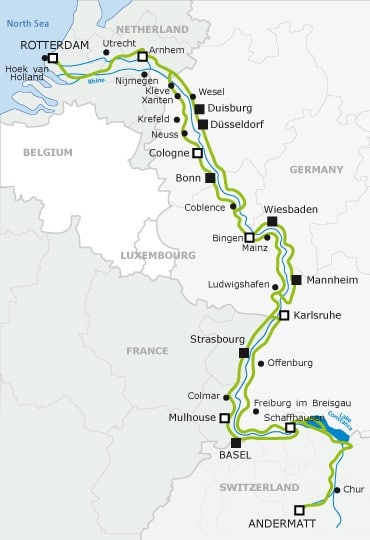Journey along the river Rhine, June and July 2019
The height of the Summer in late June and early July seemed a sensible time of year for a sedate journey along the whole length of the river Rhine. A downhill beginning from the source of the Rhine high up in the Swiss Alps would conclude – after a full two weeks of cycling – with an amble along the sea front at the Hook of Holland, where the river flows out into the North Sea. Plenty of sunshine to look forward to, although mountainous regions are prone to dramatic thunder storms and the seaside .. well, who would dare to predict a weather forecast for the seaside ?
Four intrepid, albeit ageing travellers will journey (in the first place by plane to Zurich) by the comfort of touring bicycles along what is known as EuroVelo 15. This very flat pathway manages to avoid the highways and the motor vehicles and provides a tranquil route alongside one of Europe’s major rivers, a number of UNESCO World Heritage Sites (principally, the visually dramatic Rhine gorge) and through six European countries : Switzerland, Liechtenstein, Austria, France, Germany and the Netherlands. Having reached the source by climbing an Alpine pass, cyclists face very few uphill gradients after that, the final one being in Holland as the route dips a few metres below sea level.
EuroVelo 15 is acknowledged to be a high quality path, available for use by people walking/rambling, on cycles of all shapes and sizes and also by people on horseback. The route has the benefit of many cafés, restaurants and sundry other watering holes, as well as cycle shops providing spares and repairs. The four of us intend making fulsome use of the former, whilst seldom needing the latter. Even the sign posts are plentiful and accurate.
The southern section is regarded as the most spectacular, with the Austrian and the Swiss Alps simultaneously in view. After reaching Lake Constance, renowned for its size and beauty, the route heads west towards Basel and north to Strasbourg and into the Alsace region. Control of this attractive region, which has the Vosges mountains to the west and Germany’s Black Forest to east, has been fought over for centuries by France and Germany.
Two of the UNESCO World Heritage Sites are to be found in the area near to Strasbourg – (1) Neuf-Brisach is a star-shaped village stronghold built to defend the French border with the Roman Empire; (2) the Grande île (historic centre area) is characterised by a maze of stone alleyways, canals and timber houses and is described as having a fairy-tale appearance. The largest canal locks in France are at Gambsheim and Kembs-Niffer and were built by Le Corbusier. Cathedrals appear all along the route. Speyer has a Cathedral which is a fine example of Romanesque architecture. Strasbourg’s Cathedral of Notre Dame (built from 1015 to 1439) is considered a masterpiece of Gothic art. The tallest tower of the Cathedral at Cologne reaches up to 157 metres, almost half the height of the Eiffel tower.
To the north of the Alsace, much time is spent in a beautiful region of Germany, including the city of Cologne, complete with ancient castles, attractive towns and villages and the timeless grey-green river Rhine. Castles abound. Near to the small town of Gernsheim, some distance to the south-east of Koblenz, is an old castle hidden in pine trees which is said to have been the inspiration for Mary Shelley’s ‘Frankenstein’ horror novel. The dreadfully miserable weather in that area, around that time, was thought to be equally inspirational for the story.
Some people in history have regarded the river Rhine as merely a border between Germany and its neighbouring countries. However, the German nation takes great pride in the importance of the Rhine, this river being vital especially to industry and commerce. For centuries, large boats have brought goods along the Rhine and into Europe from the port of Rotterdam.
Alongside the Rhine are many important industries, from car manufacture, vineyards and wine production and breweries to the heavy industries of the Ruhr. Zeppelins are still manufactured in Germany and it is possible to see some of them on test flights near to the Rhine. Moving on further north, the region may not have the natural beauty of the Alps, instead a notable landmark being the enormous BASF chemical works.
The area of Mannheim and Karlsruhe has considerable transport connections. In 1817, Karl Dreis unveiled his velocipide, a wooden contraption recognisable as a bicycle, although pedals and a chain were not yet in place. Later on, in the 1880s, a young engineer, Karl Benz, developed the world’s first practical automobile powered by an internal combustion engine. Apparently, this early version of a ‘car’ broke down almost every time Benz took it out.
The Rhine will entice anyone who has an interest in military history. Although there is no longer too much evidence within Germany of the nation’s second World War history, the route does travel through Bonn, formerly the capital city of West Germany during the Cold War, prior to the demolition of the Berlin Wall. As the Rhine leaves Germany and enters Holland, the mood becomes sombre as the journey takes us through the city of Arnhem where Allied forces were defeated by the Nazis in September 1944.
Cycling westwards through the Netherlands, the penultimate day is spent in Rotterdam, before an overnight ferry crossing from the Europort to Hull and the last day’s ride home to Rotherham.
Richard Bellamy
Richard Bellamy, Dave Buxton, Mahmood Hussain, Tom Knight are raising money for Shiloh Rotherham because we want to see the end to the Cycle of Homelessness. Please donate on our JustGiving page. Thank you.
https://www.justgiving.com/fundraising/rotherham-wheelers-cycling-club1
A map of the whole route appears below.

